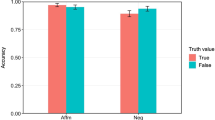Abstract
This review article examines how children verify a statement (e.g.,You are a child. Right or wrong?) and answer a corresponding question (e.g.,Are you a child? Yes or no?) in English, French, Japanese, and Korean. While people verify affirmative statements and answer affirmative questions similarly across the four languages, they answer negative questions differently across the four languages. In English, answering negative questions works in a way opposite to verification (e.g.,Are you not a child? Yes; You are not a child. Wrong). In French,si is used in the place of theyes response in English. In Japanese and Korean, answering negative questions works in a way similar to verification (e.g.,Are you not a child? No; You are not a child. Wrong). The effects of these linguistic characteristics are examined. Findings are: (1) All children across the four languages appear to start answering negative questions using the English system; (2) English-speaking children find verifying negative statements more difficult than answering the corresponding questions but Japanese-speaking children find it less difficult; and (3) while English-speaking and Korean-speaking children find true negative statements more difficult to verify than false negative statements, Japanese-speaking children find them less difficult. Language-universal and language-specific processes in verification and answering are discussed.
Similar content being viewed by others
References
Akiyama, M. M. (1979). Yes-no answering systems in young children.Cognitive Psychology, 11, 485–504.
Akiyama, M. M. (1984). Are language acquisition strategies universal?Developmental Psychology, 20, 219–228.
Akiyama, M. M. (1985). Denials in young children from a cross-linguistic perspective.Child Development, 56, 95–102.
Akiyama, M. M., Brewer, B. F., & Shoben, E. J. (1979). The yes-no question answering system and statement verification.Journal of Verbal Learning and Verbal Behavior, 18, 365–380.
Akiyama, M. M., & Guillory, A. W. (1983). The ontogeny of the verification system.Journal of Verbal Learning and Verbal Behavior, 22, 333–340.
Akiyama, M., Takei, S., & Saito, K. (1982). Statement verification and question answering.Japanese Journal of Educational Psychology, 30, 215–222.
Brown, R. (1973).A first language. Cambridge, MA: Harvard University Press.
Brown, R., & Hanlon, C. (1970). Derivational complexity and order of acquisition in child speech. In J. R. Hayes (ed.),Cognition and the development of language. New York: John Wiley and Sons.
Carpenter, P., & Just, M. A. (1975). Sentence comprehension: A psycholinguistic model of sentence verification.Psychological Review, 82, 45–73.
Choi, S. (1991). Children's answer to yes-no questions: A developmental study in English, French, and Korean.Developmental Psychology, 27, 407–420.
Christopher, R. C. (1983).The Japanese mind. New York: Fawcett Columbine.
Clancy, P. M. (1985). The acquisition of Japanese. In D. I. Slobin (Ed.),The crosslinguistic study of language acquisition: Vol. 1. The data. Hillsdale, NJ: Erlbaum.
Clark, H. H. (1973). The language-as-fixed effect fallacy: A critique of language statistics in psychological research.Journal of Verbal Learning and Verbal Behavior, 12, 335–359.
Clark, H. H., & Chase, W. G. (1972). On the process of comparing sentences against pictures.Cognitive Psychology, 3, 472–517.
Clark, H. H., & Clark, E. V. (1977).Psychology and language. New York: Harcourt Brace Jovanovich.
Ikegami, Y. (1978).Imino sekai [The world of]. Tokyo: Nippon Hoso Shuppan Kyokai.
Kim, K. J. (1985). Development of the concept of truth functional negation.Developmental Psychology, 21, 426–472.
Kim, J. L., Shatz, M., & Akiyama, M. M. (1990).Developmental Psychology, 26, 821–829.
Klima, E. S., & Bellugi, U. (1973). Syntactic regularities in the speech of children. In C. A. Ferguson & D. I. Slobin (Eds.),Studies of child language development (pp. 333–355). New York: Holt, Rinehart & Winston.
Kokuritsu-Kokugo-Kenkyujo (1982).Yoji-no kotoba shiryo [Child language data] Vol. 3. Tokyo: Shuei-shuppan.
Kuno, S. (1973).The structure of the Japanese language. Cambridge, MA: The MIT Press.
McNeill, D., & McNeill, N. B. (1968). What does a child mean when he says “no?” In C. A. Ferguson & D. I. Slobin (Eds.),Studies in child language development (pp. 619–627). New York: Holt, Rinehart & Winston.
Noji, J. (1974).Yojiki no gengo seikatsu no jittai [Child language record] Vol. 3. Hiroshima: Bunka Hyoronsha.
Noji, J. (1976).Yojikino gengo seikatsu no jittai [Child language record] Vol. 2. Hiroshima: Bunka Hyoronsha.
Okubo, A. (1967).The development of child language [Yoji gengo-no hattatsu]. Tokyo: Tokyodo Shuppan.
Pope, E. (1973). Question answering systems. Paper presented at the 9th regional meeting of the Chicago Linguistic Society, Chicago.
Saigusa, M. (1978).Nihon bunpo [Japanese grammar]. Tokyo: Iwanami Shoten.
Steffensen, M. S. (1978). Satisfying inquisitive adults: Some simple methods of answering yes/no questions.Journal of Child Language, 5, 221–236.
Stockwell, R., Schacter, P., & Partee, B. (1973).The major syntactic structure of English. New York: Holt, Rinehart and Winston.
Strunk, W., & White, E. B. (1972).The elements of style. New York: Macmillan.
Tanenhous, M. K., Carroll, J. M., & Bever, T. G. (1976). Sentence picture verification models as theories of sentence comprehension: A critique of Carpenter and Just.Psychological Review, 83, 310–317.
Watanabe, K., & Suzuki, T. (1981).Chosengo-no susume [Invitation to Korean]. Tokyo: Kodansha.
Author information
Authors and Affiliations
Additional information
A portion of this article was supported by NIMH grant 1 RO3 MH34606-01. The author wishes to thank Marilyn Shatz, Kazuko Inoue, and Edward Shoben for their willingness to discuss some of the theoretical issues presented in this paper, and John Macnamara, Brian MacWhinney, Sam Glucksburg, and Susan Gelman for their helpful suggestions. The author also wishes to thank Rick Pollack and Belinda Biscoe for their helpful reading of an earlier version of this manuscript.
Rights and permissions
About this article
Cite this article
Akiyama, M.M. Cross-linguistic contrasts of verification and answering among children. J Psycholinguist Res 21, 67–85 (1992). https://doi.org/10.1007/BF01067988
Issue Date:
DOI: https://doi.org/10.1007/BF01067988




